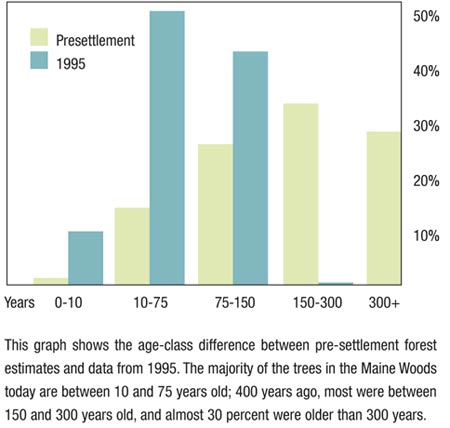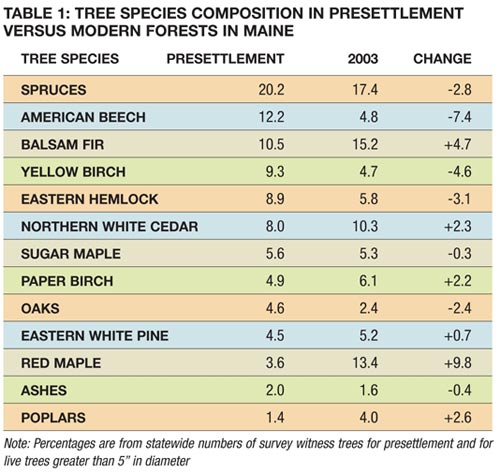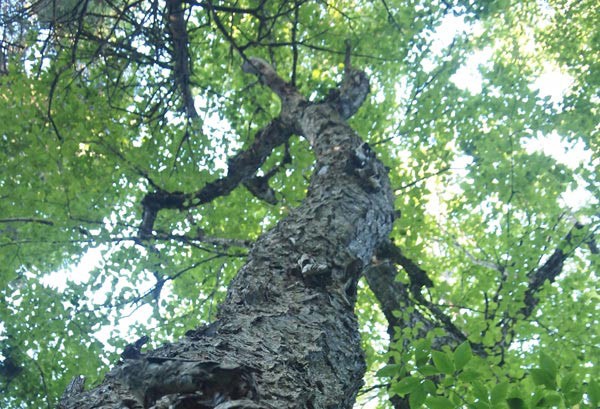The New England settlement story is a familiar narrative. We all know the tale: farms hacked out of daunting woods in the eighteenth century, rolling Agricultural lands in the nineteenth century, and abandoned fields reverting to forest in the twentieth century. There’s only one problem: That’s not what happened in Maine.
Euro-Americans colonized the Maine coast in the 1600s and early 1700s, but much of this occupation was repulsed by Abenaki tribes. After the Revolutionary War, a larger wave of settlers pushed inland, quilting southern and central Maine with farms and in the process clearing more than three million acres of forest. But after the Civil War, immigration into the state slowed to a trickle, and many people left their Maine farms for better land in the Midwest, or the industrializing cities of the Northeast. As a result, settlers never reached most of the northern half of the state, leaving about 14-15 million acres of forest intact. In short, the business plan to settle the state never materialized.
There is no state like Maine in the eastern U.S. where such a large chunk of contiguous land has remained continuously forested since pre-settlement times. It’s tempting to look for similarities with the western U.S., where vast forests were never cleared. Most of those lands, however, are managed by the federal government. Most of the Maine Woods are privately owned, and that has led to a very different kind of relationship between people and forests. Maine, in other words, has carried out its own unique, long-term experiment in land use.
What are the consequences of this 400-year experiment? Does today’s forest look like the forest before European settlement? Have the characters in the story – the plants and animals and other species – changed in any appreciable way?
Uncovering the Past
Historical ecologists have spent decades reconstructing what pre-settlement forests were like in Maine. It’s challenging work, as we’re talking about ecosystems that existed 200 to 600 years ago, differed widely across the state, and were never static. No single approach or type of data will suffice; we must rely on multiple lines of evidence that operate at different geographic scales and combine history, biogeography, archaeology, surveying, natural history, and ecology.
Our first clues come from early explorers who wrote about coastal forests. The earliest of these observations, in the 1500s, are not especially revelatory, such as this description from Giovanni da Verrazano in 1524: “nothing extraordinary except vast forests.” When the early settlers did get specific, their tree naming was often rudimentary and flexible. The early usage of “fir,” “spruce,” or “cypress,” for example, could have referred to any conifer.
But by the 1600s, some explorer journals record detailed observations, such as the following description of the Camden Hills from the 1605 Waymouth voyage:
passed over very good ground, pleasant and fertile, fit for pasture, for the space of some three miles having but little wood, that Oke like stands left in our pastures in England, good and great, fit timber for any use. Some small birch, Hazle and Brake . . . Upon the hills grow notable high timber trees, masts for ships of 400 tun.
A second source of clues comes from land surveys, from which one can tease data related to topography, water drainage, forests, natural disturbance, and specific trees. Surveyors used witness trees to mark boundaries, and the frequency of these trees in survey records provides a reliable estimate of the species composition of the forest at that time. Charles Cogbill has collated presettlement land survey records and recorded 23,490 witness trees in what is now Maine. This includes some 36 species (or closely related groups of species) in 180 towns. For example, a 1789 survey by Ephraim Ballard in west-central Maine noted eastern hemlock, American beech, northern white cedar, birches, maples, northern red oak, and American basswood. A survey in the far northern tip of Maine in Aroostook Township in 1845 describes a very different forest: lots of fir and spruce, some hardwoods, and balm of Gilead (balsam poplar).
But the human record is only part of the story. Paleoecologists use preserved pollen, macrofossils, charcoal, and insect remains to reconstruct environments of the past. As the glaciers receded, Maine was dotted with lakes and ponds onto which all manner of wind-blown flotsam – pollen, seeds, cones, leaves of plants, even bits of charcoal from fires – blew and sank to the bottom. Lakes slowly filled with organic matter, some remaining as bodies of water, others developing into bogs or fens. Low oxygen levels slowed decomposition in these sediments, and the embedded detritus was preserved, layer upon layer.
Using radiocarbon dating on these bog cores, we’ve been able to reconstruct a pollen chronology that records more than 14,000 years of forest changes in Maine – from tundra to spruce-fir to a drier pine-birch-oak forest to mixed hardwoods and, finally, to the mixed hardwoods and softwoods the explorers found.
Historical records and 14,000-year-old sediment samples are intriguing, but we can’t forget to simply go out into the woods and see what’s there. Presumably, old growth forests resemble presettlement forests and contain clues about forest composition, structure, and the roles of various disturbances in shaping them. Maine has scarcely any old growth remaining – mostly tiny stands (or stunted vegetation on high mountains) that have survived because of an idiosyncratic history of ownership, condition, or location. Fortunately, The Nature Conservancy’s Big Reed Forest Reserve protects a singular Maine old growth landscape of 5,000 acres.
By analyzing cores from 6,909 trees (63 dating from before 1750, the oldest prior to 1555), Alan White and his graduate students were able to reconstruct a record of how much the Big Reed forest has been naturally disturbed by fire, wind, ice, and other natural phenomena. They found that the average stand disturbance rate is only about 9 to 12 percent per decade and projected that a major disturbance (over 50 percent disturbed) would occur only once every 1,100 years. Big Reed Forest Reserve also provides a glimpse of the rich species diversity (26 different tree species!) that the unmanaged presettlement forest would have supported.
No one line of evidence is sufficient to reconstruct the presettlement Maine Woods, as each has advantages but also weaknesses: only the witness tree data provide a nearly comprehensive geographic view; only the paleoecology studies reveal changes over relatively long time periods; only Big Reed’s old-growth landscape offers details about forest dynamics and allows us to see and measure a forest that resembles those of presettlement times. Taken together, however, the lines of evidence reveal a picture of what the presettlement forest looked like, how it operated, and how it varied across the landscape.
Maine Forests Then and Now
So what do we find when we compare the forest of today with the forest first encountered by settlers in the seventeenth century? Remarkably, Maine’s forest area today is about the same as it was four centuries ago. Maine is 21.3 million acres (19.8 million is land). In 1600, 18.2 million acres were forest; today’s forest covers 17.7 million acres.

The major forest regions have also been largely stable since presettlement times. Cogbill’s analysis of witness trees reveals four major forest zones before European settlement: a southwestern oak-pine district (with some outliers eastward along the coast); a west-central province of northern hardwood forest, with beech as the most abundant species; a northern zone of spruces, fir, northern white cedar, yellow birch, and lesser amounts of other northern hardwoods; and a coastal area east of Casco Bay, largely of spruce and hemlock. These zones are widely recognizable in modern forests and are the basis of most forested land classifications in the state. Despite considerable change in climate, land use, and many other environmental factors, the forest regions and transition zones have been remarkably stable.
This is not to say that the distributions of all species have been static. The Carolina wren, northern cardinal, Virginia opossum, and less welcome species such as ticks and invasive plants have all migrated north over the past century. If we widen the focus to all of New England, the list of northward traveling species is large and taxonomically diverse, with frequent new reports. Many of these migrations appear to be connected to the warming climate of the Northeast.
Given that Maine is already a warmer place than it was a half-century ago, why haven’t tree species responded in some conspicuous way? Part of the explanation is obvious: they don’t have feet or wings with which to get up and go; their migration depends on an annual march of seeds in whatever direction is favorable. But trees differ from many other types of organisms in another important way. Once established, trees tend to be tolerant of all manner of assaults from the environment. They also live for a long time, and so have an intrinsic inertia that may well slow their response to climate change.
Despite the similarities in forest cover and geography, the modern Maine Woods do differ from presettlement forest in fundamental ways. A visitor from the seventeenth century would find many familiar organisms, but key species, such as the gray wolf, mountain lion, and caribou, are missing. The loss of two top predators has likely profoundly altered food webs in Maine forests, although the extent of these impacts is poorly known.
Many species of fauna and flora have immigrated to Maine, and they predominate in some sites. A recent assessment of Maine’s biodiversity found that about one-third of the 2,107 wild plant species in the state are exotics. Some of these will be very familiar: purple loosestrife, Japanese knotweed, common buckthorn, Oriental bittersweet. But others – lupine, black locust, and apple trees, for example – have become such an integral part of the Maine landscape that most people would be surprised to learn of their nonnative status. This goes for animals, as well, especially birds. European starlings, pigeons, and house sparrows – all abundant in Maine – are European species.
There is circumstantial evidence that some forest-dependent herbs, mosses, and lichens have become rare as a result of centuries of land clearing and harvesting. Modern Maine forests also tend to be lacking in large-diameter classes of dead organic matter, such as snags, cavity trees, and logs, which provide habitat for vertebrates, invertebrates, bryophytes, lichens, and fungi, and supply nutrients to plants and other organisms. Whether other presettlement species, especially inconspicuous ones, have been extirpated by land use changes is an open question. Our knowledge even of Maine’s current biota is far from complete, especially for the small, the inconspicuous, the economically unimportant, and those with too many legs.
Our research shows that the relative abundance of tree species in Maine has also changed since presettlement times. The largest declines have been for beech, yellow birch, hemlock, oaks, and spruces; the largest increases have been for red maple, poplars, balsam fir, and white pine. These transformations were caused, albeit through complex and often indirect means, by the people who settled and have lived in Maine for these last few centuries. Increased fire incidence during settlement favored birches and white pine and acted against fire-sensitive species such as red spruce, hemlock, and beech. Accidentally introduced beech bark disease has decimated beech. Frequent harvesting has favored species that respond well to disturbance, such as poplars (aspens), paper and gray birch, black and pin cherries, and red maple. In the north, 150 years of spruce harvesting has benefitted balsam fir.

The physical structure of Maine’s forests has changed, too. Maine never did support giant trees, with the exception of some white pines, which were not as abundant as one might think (Table 1). But because of high harvest levels, trees in Maine today are much smaller and younger than in presettlement times. The Maine Forest Service’s most recent statewide inventory found that of trees over 5 inches in diameter, only 7.2 percent are in the 13- to 21-inch diameter range, and only 0.5 percent are larger than 21 inches. For comparison, of trees in the old growth at Big Reed Forest Reserve larger than 4 inches in diameter, 20 percent are greater than 14 inches and 5 percent are greater than 20 inches. Land survey records suggest that about 60 percent of the presettlement forest of Maine was older than 150 years, a value that had declined to about 1 percent by 1995. Of the original oldgrowth forests, only about 0.05 percent remain today.
After examining the old growth at Big Reed Forest Reserve, we also suspect that the larger, older trees of the presettlement forest gave these woods a different texture beyond just diameter and height, for large specimens of some species simply look different from the smaller versions we’re used to. The typical shiny yellow, somewhat stringy bark of yellow birch trees, for example, is replaced by large, grayish, platy blocks on large trunks of this species.
The Maine Woods remain a vast territory that supports a wide range of species. The last four centuries of land use, however, have altered the original forest, favoring generalist and disturbance associated species, reducing tree size and age, and decreasing structural complexity. The southern Maine forest has changed from an old-growth mixed-hardwood forest to a network of suburban and rural forests, much established on formerly cleared land. The northern forest has changed from a structurally heterogeneous spruce-hardwood forest to a more homogeneous, younger fir-spruce forest. Although vast and complex, the modern Maine forest is very much a product of human culture.
What might this mean for the future of Maine forests? Returning to the presettlement forest is not possible, given the scale of forest and environmental change. On the other hand, we can support elements of that landscape – mature forest, coarse organic matter, structural complexity – that are essential for the maintenance of biological diversity. Past land use matters, as it clearly constrains what is possible for future forests. But Maine’s forest history tells us that there are many potential paths within those ecological boundaries.
This article is adapted from the author's 2012 book, The Changing Nature of the Maine Woods, which explores the following topics in greater depth. Sources for the article can be found there.


